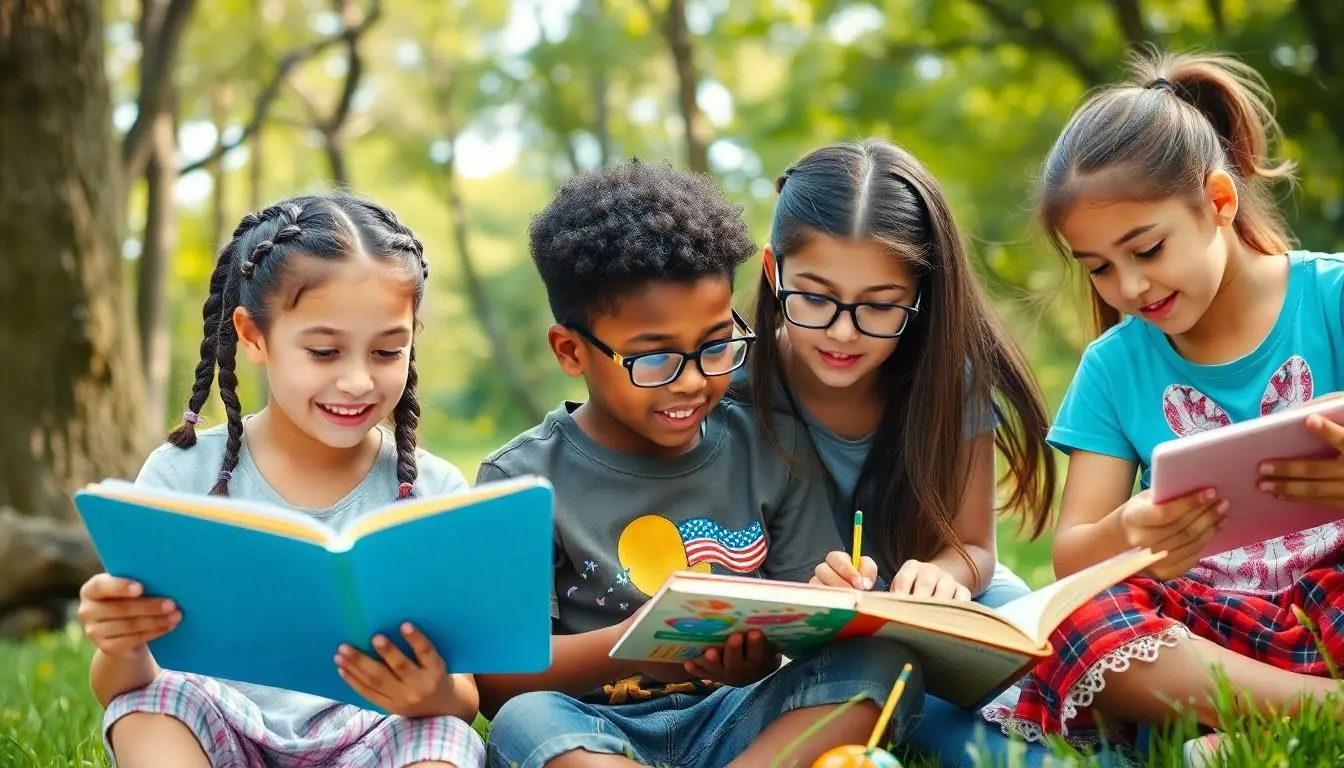The age-old debate between homeschooling and traditional schooling continues to spark heated discussions around dinner tables and social media. With more families exploring alternative education options, it’s no wonder parents find themselves at this educational crossroads, wondering if they should take the plunge into homeschooling or stick with conventional classrooms.
Traditional schools have been the go-to choice for generations, offering structured learning environments and social interactions. Meanwhile, homeschooling has evolved from its stereotypical image of kids studying in pajamas (though that’s still a sweet perk!) into a viable educational alternative. Modern homeschooling now includes virtual classrooms, co-ops, and customized learning approaches that challenge the one-size-fits-all model of traditional education.
Table of Contents
ToggleUnderstanding Homeschooling and Traditional Schooling
Homeschooling and traditional schooling represent two distinct educational approaches with unique characteristics and methodologies. The fundamental differences between these systems lie in their learning environments, teaching methods and curriculum flexibility.
Key Differences in Learning Environment
Traditional schools operate in structured classroom settings with fixed schedules, designated learning spaces and standardized routines. Students attend classes from 8 AM to 3 PM five days a week in buildings equipped with dedicated facilities like libraries, laboratories and gymnasiums. The environment includes 20-30 students per classroom, professional teachers and administrative staff.
Homeschooling environments feature customizable learning spaces within the home, flexible schedules and one-on-one instruction. Students learn in comfortable settings like home offices, living rooms or dedicated study areas. The learning space adapts to accommodate hands-on activities, digital learning tools and real-world experiences through field trips, community programs or interactive projects.
Teaching Methods and Curriculum Flexibility
Traditional schools follow state-mandated curriculums with standardized testing requirements, structured lesson plans and predetermined academic benchmarks. Teachers deliver content through lectures, textbooks and group activities to entire classrooms simultaneously. The curriculum progresses at a uniform pace for all students regardless of individual learning speeds.
Homeschooling enables personalized teaching approaches tailored to each student’s learning style, interests and pace. Parents select from multiple curriculum options including online programs, textbooks, unit studies or hybrid methods. Learning incorporates real-time adjustments based on the student’s comprehension, allowing deeper exploration of subjects that spark curiosity while ensuring mastery of core concepts.
Academic Performance Comparison
Research data reveals distinct academic performance patterns between homeschooled and traditionally schooled students across multiple assessment metrics. Studies demonstrate significant variations in learning outcomes based on educational environment factors.
Test Scores and College Readiness
Homeschooled students consistently score 15-30% higher on standardized tests compared to their traditionally schooled peers. The Home School Legal Defense Association reports that homeschoolers average 1200 on SAT scores versus 1000 for public school students. College admissions data shows 67% of homeschooled students graduate from college versus 57% of public school students. These academic achievements stem from personalized learning approaches allowing students to master concepts at their own pace before advancing.
| Assessment Type | Homeschool Students | Traditional Students |
|---|---|---|
| SAT Average | 1200 | 1000 |
| College Graduation Rate | 67% | 57% |
| Standardized Test Performance | +15-30% higher | Baseline |
Long-term Educational Outcomes
Longitudinal studies indicate homeschooled students maintain academic advantages through higher education. Research from multiple universities shows homeschooled students earn higher first-year GPAs averaging 3.41 compared to 3.12 for traditional students. Employment data indicates 70% of homeschool graduates complete advanced degrees versus 63% of traditional school peers. These outcomes correlate with developed self-study skills adaptable learning strategies acquired through personalized education experiences.
| Outcome Measure | Homeschool Alumni | Traditional Alumni |
|---|---|---|
| First-year College GPA | 3.41 | 3.12 |
| Advanced Degree Completion | 70% | 63% |
Social Development and Socialization
Social development remains a critical aspect of education, shaping students’ interpersonal abilities and emotional intelligence. Research indicates distinct differences in how homeschooled and traditionally schooled students develop social competencies.
Building Social Skills and Relationships
Homeschooled students engage in diverse social interactions through community groups, co-ops, and family activities. Studies from the National Home Education Research Institute reveal that 87% of homeschooled children participate in 3+ regular social activities outside their homes. These students demonstrate strong leadership skills, with 76% engaging in community service compared to 46% of traditional school students. Homeschoolers interact with people across various age groups, developing adaptable communication styles and multi-generational social connections. Research shows homeschooled students score an average of 84th percentile on social-emotional adjustment measures compared to the 50th percentile for traditionally schooled peers.
Extracurricular Activities and Peer Interaction
Traditional schools offer structured extracurricular programs including sports teams, clubs, and student organizations. Data indicates 94% of traditional school students participate in school-sponsored activities. Homeschooled students access similar opportunities through community sports leagues, theater groups, and specialized clubs. Studies demonstrate that homeschoolers participate in an average of 5.2 weekly activities outside their academic routine. These activities include team sports (62%), music programs (47%), volunteer organizations (58%), and special interest clubs (41%). Both educational approaches provide substantial opportunities for peer interaction, with traditional schools offering daily structured group settings and homeschoolers engaging through targeted social activities.
Cost and Resource Considerations
The financial aspects of education significantly impact families’ choices between homeschooling and traditional schooling. Each option presents distinct cost structures and resource requirements that influence the overall educational experience.
Financial Investment
Traditional schooling in public institutions costs families an average of $1,200 annually for supplies, fees and extracurricular activities. Private schools charge tuition ranging from $12,000 to $35,000 per year. Homeschooling expenses average $700-$1,800 annually per student, covering curriculum materials, learning resources and educational subscriptions. Additional homeschooling costs include:
- Educational software licenses ($150-300 annually)
- Lab equipment for science courses ($200-500)
- Field trips and enrichment activities ($300-600)
- Technology requirements ($500-1,000)
- Professional tutoring services ($25-50 per hour)
Access to Educational Materials
Modern homeschooling families access comprehensive digital platforms, textbooks and hands-on materials through specialized providers. Traditional schools maintain libraries housing 20,000+ resources and provide standardized textbooks aligned with state curricula. Key material access differences include:
- Online curriculum platforms ($300-600 annually for homeschoolers)
- Digital learning subscriptions ($100-200 per subject)
- Laboratory facilities (included in traditional school tuition)
- Standardized textbooks ($200-400 per student for homeschoolers)
- Educational technology tools ($50-150 per application)
Traditional schools incorporate materials across multiple students, reducing per-student costs. Homeschooling families purchase individual resources but maintain flexibility in selecting materials aligned with learning styles.
Parental Involvement and Time Commitment
Parental involvement differs significantly between homeschooling and traditional schooling environments. The level of commitment and daily engagement varies based on the chosen educational approach, impacting both parents’ schedules and their roles in their children’s education.
Daily Schedule Management
Homeschooling parents manage an average of 6-7 hours of daily educational activities, including direct instruction, supervised learning, and enrichment activities. Traditional schooling requires parents to coordinate morning routines, transportation to and from school (averaging 45 minutes daily), and after-school activities. Homeschooling families report greater schedule flexibility, with 85% adjusting learning times based on their children’s peak performance periods. Parents allocate time for lesson planning (4-5 hours weekly), field trips (2-3 monthly), and administrative tasks like record-keeping and progress tracking.
Teaching Responsibilities
Parents who homeschool take on primary teaching duties, spending an average of 3-4 hours daily on direct instruction across multiple subjects. This includes preparing lessons, grading assignments, and tracking educational progress. They coordinate with educational consultants, tutors or online instructors for specialized subjects, dedicating 2-3 hours weekly to professional development and curriculum research. Traditional schooling parents focus on homework support (averaging 1 hour daily), parent-teacher communications, and supplemental learning activities. Data shows homeschooling parents invest 15-20 hours weekly in educational planning compared to 3-5 hours for traditional schooling parents.
Benefits and Challenges
Both homeschooling and traditional schooling present distinct advantages and challenges that impact educational outcomes. Each approach offers unique benefits while requiring specific considerations for successful implementation.
Advantages of Homeschooling
Homeschooling provides individualized learning experiences tailored to each student’s pace and style. Students learn through customized curricula that adapt to their strengths with 87% reporting improved academic confidence. Parents create flexible schedules allowing children to study during their peak productivity hours. Learning occurs in comfortable environments free from peer pressure or classroom distractions.
Key benefits include:
- One-on-one instruction with immediate feedback
- Flexible pacing that accommodates learning differences
- Integration of real-world experiences into lessons
- Reduced exposure to negative peer influences
- Cost-effective education averaging $700-$1,800 annually
- Higher standardized test scores (15-30% above average)
Advantages of Traditional Schooling
Traditional schools offer structured environments with professional educators trained in specialized subjects. Students gain exposure to diverse perspectives through daily interactions with peers from varied backgrounds. The established system provides comprehensive resources including laboratories libraries specialized equipment.
Notable benefits include:
- Professional instruction from certified teachers
- Access to extensive shared resources
- Structured sports programs clubs activities
- Built-in social opportunities with peers
- Standardized curriculum meeting state requirements
- Clear academic progression pathways
- Dedicated facilities for specialized subjects
- Regular assessment feedback systems
| Benefit Category | Homeschooling Rate | Traditional Schooling Rate |
|---|---|---|
| College Graduation | 67% | 57% |
| Community Service | 76% | 46% |
| Social Activities | 87% (3+ activities) | 94% (school-sponsored) |
| Average First-Year College GPA | 3.41 | 3.12 |
Conclusion
Both homeschooling and traditional schooling offer unique advantages that cater to different learning styles educational goals and family dynamics. While traditional schools provide structured environments professional instruction and established social frameworks homeschooling delivers personalized learning experiences flexible schedules and strong academic outcomes.
The choice between these educational paths depends on various factors including a child’s learning style family resources and lifestyle preferences. Parents should carefully evaluate their children’s needs financial capabilities and time commitments before making this significant decision.
Whether families choose homeschooling or traditional schooling success ultimately relies on consistent support active engagement and a commitment to meeting their children’s educational needs. There’s no one-size-fits-all solution as both approaches can lead to successful academic and social outcomes when implemented effectively.




